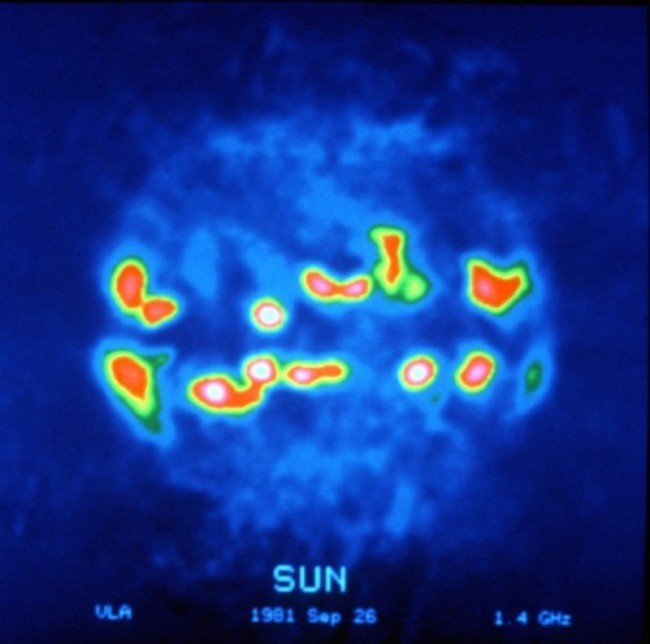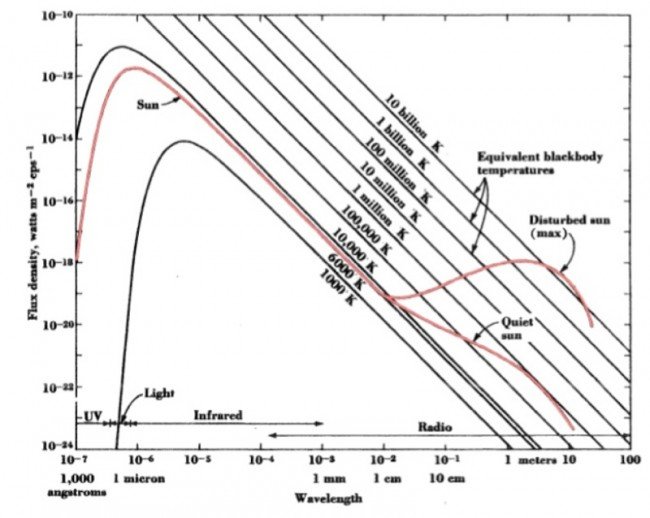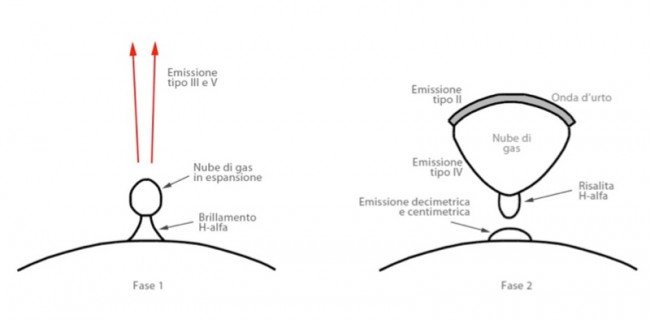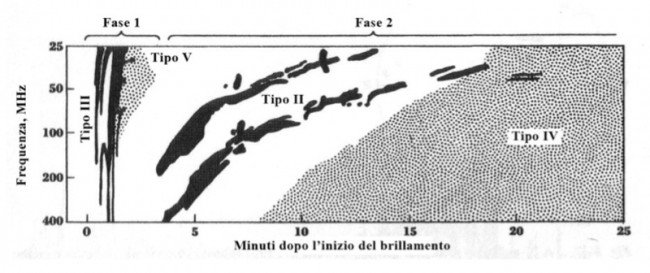The Sun is one of the strongest radio sources in the sky: if the part of the Sun emits more in the visible wavelengths is called photosphere, the radio frequencies born in the chromosphere and in the corona, the solar atmosphere. The solar surface has a temperature of about 6000K, and even if the gas at this temperature emits more wavelengths in the frequencies of visible and ultraviolet light, because of its proximity we can also record the radio emission.

The radio Sun: radio image of the Sun recorded by VLA. The brightest regions are part of corona nearby but beyond sunspots. Courtesy (NRAO/AUI)
The Sun emits radio waves since it’s hot hot (it is said that it is a thermal source and then emits radio waves more at high frequencies) but there is a strong emission even at lower frequencies (in the field of non-thermal sources) for the mechanism of synchrotron radiation which derives from the movement of high speed electrons around the magnetic field.
If we analyze the flux density (in simplified terms, the amount of radio waves arriving from the Sun) emitted as a function of frequency, we can highlight a second peculiarity: at wavelengths greater than 1 cm the curve is divided into two cases identified as “quiet Sun” and “disturbed Sun”. The first is defined from normal Sun activity while the second depends on the sunspots activity.

The radio Sun: sun spectrum from ultraviolet to radio waves (from “Radio Astronomy, J. D. Kraus”)
In reference to “quiet Sun” emission , the solar disk has a different diameter in function of study frequency.
- At very low frequencies (below 0.1 GHz) and therefore at very long wavelengths (> 3m) the solar disk appears much bigger and brighter in the center, and its brightness gradually decreases and vanishes after several solar radii.
- For frequencies between 0.1 GHz and 3 GHz, the Sun is still larger than its optical counterpart and a radio peak intensity near the edge called limb brightening is noticeable.
- For frequencies above 3 GHz the Sun appears similar (though still greater in size) to its visible counterpart and its brightness is uniform.
From these considerations it is possible to verify that higher frequency radio waves originate closer to the photosphere, the ones with lower frequency in the corona, which then gives the Sun a greater dimension in the sky.
In the case of a ‘disturbed Sun’, it is possible to delineate a low variability component, ranging from days to months, which is evident at wavelengths from 3 to 60 cm and a high variability component characterized by strong emissions of radiation in time intervals from seconds to hours. The first component is closely associated with the presence of sunspots even when not directly visible because they are beyond the edge of the Sun. Then this radio emission originates in regions above the photosphere.
The second component (with high variability) instead is linked to strong emissions that follow the occurrence of flares, violent matter explosions initially visible in the visible band of H-alpha (for example with specialized solar telescopes). Flares can be divided into impulsive or eruptive. The former have a short duration, from seconds to minutes, and develop only in the lower layer of the solar atmosphere. The latter have longer life, from minutes to hours, and can generate huge amounts of energy and matter ejected into space. Flares are caused when charged particles are suddenly accelerated. The energy required for this acceleration is derived from the magnetic field around the most active areas of the solar surface. During the impulsive phase of the flare, there is a fast increase in the intensity of radio waves with centimeter or decimetre wavelengths. The most powerful eruptive flares emit radiation for several hours.
The radio activity bound to these phenomena is classified (Wild, Smerd, Weiss , 1963) in function of the characteristics of this emission:
- Type I: short events that occur in large numbers associated with a continuous emission (duration: from hours to days)
- Type II: strong events with frequency shift from high to low values (duration: minutes)
- Type III: strong events with short duration with frequency shift from high to low values (duration: seconds)
- Type IV: continuous emission (duration: from hours to days)
- Type V: continuous emission associated to type III, recorded in frequencies lower than 100 MHz (duration: 1-2 minutes)
The characteristics of these types are well illustrated when considering the events that follow a solar flare.

The radio Sun: Representations of the two phases following a solar flare (from: Wild, Smerd, Weiss – Solar Bursts, Ann. Rev. Astron. Astrophys., vol. 1, 1963)
In phase 1, there is a strong type III emission immediately after the onset of a flare visible in the H-alpha line. There is a very strong radio emission that ends quickly and that, it is believed, is derived from the oscillations of the plasma associated with the expulsion of electron beams in response to flare. Sometimes, especially at frequencies below 100 MHz , the flare is associated with a more continuous and long lasting emission, the type V. The electromagnetic waves of this type are generated by the acceleration of electrons along the magnetic field lines in the corona.
In events strongest , ie in the eruptive ones, there is also the phase 2 which begins with short and net signals peaks which often also include a second repeat (harmonic). This emission comes by the shock wave front to the gas cloud above the flare. At times, immediately after you can record a weaker but continuous signal that can last from hours to days and that is called type IV . The latter is related to the synchrotron emission coming from the gases above the flare and it can have short and strong signal peaks classified as type I.
Among the radio burst type IV there is one type , called “mu-burst type IV” , in which the signal is emitted, with wavelengths from 30 cm to 1 cm, so even above 10 GHz. This allows us to understand that the SPIDER radio telescopes can also be used for studies of thesesolar atmosphere phenomena, possibly associated with a H-alpha solar telescope to study simultaneously the different components of the electromagnetic spectrum coming from the same phenomenon, namely a flare.

The radio Sun: radio spectrum of an intense event linked to flares (from: Wild, Smerd, Weiss – Solar Bursts, Ann. Rev. Astron. Astrophys., vol. 1, 1963)
Sometimes, during the most intense phenomena, high energy cosmic particles are emitted from the Sun and, when they encounter the Earth’s magnetic field, they generate magnetic storms and auroras.
